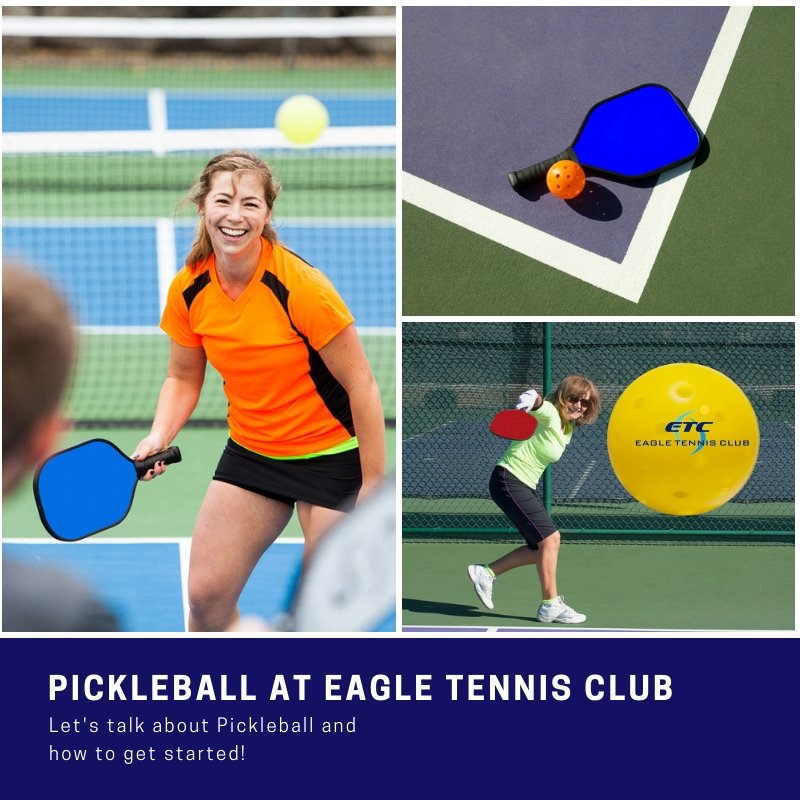Pickleball is a court sport best described as half way between tennis and ping-pong. The court is 44’ by 20’ and divided into two halves by a 34” high net (whereas it is 36” for tennis). It is played as a singles game with one person per side or as a doubles game with 2 people on each side of the net. Each player has a paddle. Total length of the paddle is 15 ½” and the width is no more than 8”. The object of the game is to score points by successfully hitting a 3” diameter plastic ball (that is perforated with 26 holes across the net without it being successfully returned by the opponent(s).
Pickleball is very popular all across the U.S. and even in places like Singapore and japan. Many seniors have taken up the sport in their retirement years, but it is also played by thousands of school-aged children and top athletes in their 20s and 30s. It is as easy sport to learn and most everyone can play the game after just a short time of hitting the ball back and forth across the net. However, it is a sport where you can also keep learning new strokes and increasingly sophisticated strategies for years on end.
DROP IN PLAY (DIP)
Courts are reserved for Drop-in play (DIP). Players may drop-in anytime during the scheduled hours. Players are grouped on different courts according to skill level so that you play with others who have a similar skill level to you. The idea is to have fun matches but at the same time have your skills challenged by players of like skill level. DIP courts will be available scheduled pickleball times.
DIP non-member fee is $10 per visit and must be accompanied by a club member.
SKILL LEVEL DEFINITIONS
The following skill level sets are a guide for evaluating your own level. They were developed utilizing both existing guidelines listed by the USAPA (usapa.org) and from input from other pickleball clubs. This is a work in progress and we expect to continue to modify these descriptions.
ETC will use this information to develop training clinics and for seeding tournament players. Note: Exempting events which require a USAPA-or club-approved rating level, you self-rate for all other non-rated events. This means you make your own decision about what level you should play in, in existing non-rated events, using the guidelines to assist in making that decision. The purpose of rated events is to insure a consistent and competitive level of play for all players within that event as much as possible. Therefore we request that you do NOT sign up for a tournament or club event higher or lower than your rated skill level if you have a rating.
The following lists each skill level from 2.5 to 4.0+. It also adds specific detail about skills required to be at a given level.
SKILL EXPECTATIONS FOR EACH LEVEL OF PLAY
Note: Above the 2.0 level, all levels should be able to demonstrate most of the skills for their level plus most of the skills from preceding levels. Thus a 2.5 level player, for example, demonstrates most skills in the 2.5 level list as well as most skills in the 2.0 level list, and so on.
Level 2.0
- Has participated in novice and beginning skills practice
- Moves around the court in a balanced and safe manner
- Gets some serves “in”
- Realizes aspects of score-keeping, rules and where to stand on the court during serve, receive of serve, and general play
- Has some basic stroke skills, backhand, forehand, volley but has obvious weaknesses
- Familiar with where to stand in doubles play
Level 2.5
- Able to serve “in” more regularly
- Knows the two bounce rule and demonstrates it most times
- Knows where to stand on the court during serve, serve receive and general play
- Is mastering keeping score
- Aware of the soft game and occasionally tries to dink
- Working on form for ground strokes, accuracy is variable
- Makes longer lasting slow paced rallies
- Sometimes lobs with forehand with varying degrees of success
- Beginning to approach the non-volley zone to hit volleys
- Court coverage is weak but is improving
- Knows fundamental rules and can keep score
Level 3.0
- Working to keep the serve and serve receive deep
- Moves quickly towards the non-volley zone when opportunity is there
- Trying to make flatter returns (where appropriate)
- More aware of their partner’s position on the court and moving more as a team
- Developing more power in shots
- Beginning to attempt lobs and dinks with little success and doesn’t fully understand when and why they should be used
- Demonstrates improved skills with all the basic shot strokes and shot placement but lacks control when trying for direction, depth or power on shots
Level 3.5
- Demonstrates a broad knowledge of the rules of the game
- Gets high majority of serves “in”
- Able to serve and return serve deep
- Hits to the weak side of opponent often
- Demonstrates more strategies of playing during games
- Works better with partners in communicating, covering court, moving to net
- With varying consistency executes: lobs, forehand/backhand ground strokes, overheads, net volleys, and sustained dinking
- Starting to use drop shots in order to get to the net
- Knows when to make some specific placed shots in the game
- Working on mixing up soft shots with power shots to create an advantage
- Hits fewer balls out of bounds or in the net
- Dinks mostly in opponents’ kitchen and dinks lower over the net
- Able to sustain dinking in the game
- Has a moderate number of unforced errors
Level 4.0
- Beginning to play more consistently in all phases of the game
- Anticipates opponents shots resulting in good court position
- Primarily plays offensively
- Controls and places serves and return of serves to best advantage
- Puts strategy into play in the game
- Consistently varies shots to create a competitive advantage
- Works and moves well with partner – easily switches court positions when required
- Very comfortable playing at the non-volley zone. Works with partner to control the line, keeping opponents back and driving them off line
- Can block volleys directed at them
- Has good footwork and moves laterally, backward and forward with ease
- Uses strategy in dinking to get a put-away shot
- Consistently executes effective drop shots
- Demonstrates 3rd shot strategies: drop shot, lobs and fast paced ground strokes
- Hits a low number of unforced errors per game
Level 4.5
- Able to regularly convert a hard shot to a soft shot
- Exhibits patience at a superior level
- Shows noticeably increased skills, a higher level of strategy, quickness of hands and movement, judicious use of power, superior placement of shots, anticipation of play, sustained volleying skills, superior put-aways – all with consistency
- Understands strategy and can adjust style of play and game plan according to opponents strength and weaknesses and court position
- Beginning to master dink and drop shots
- Makes very few unforced errors
Level 5.0
- Has mastered all skills and strategies
- Athletic ability, quickness, and agility separates these players. Dependable in stressful situation
BASIC RULES OF PICKLEBALL
- To serve, you must drop the ball onto the paddle and hit it below the waistline in an upward movement. You must stand behind the service line to serve.
- The serve is diagonal from one side of the court to the other where it must bounce before it is returned.
- The return must again bounce, but this time anywhere on the serving team’s court before it is returned over the net. This is commonly referred to as the “Two-Bounce Rule”.
- After the first two bounces, each side can choose to hit the ball in the air (volley) or let it bounce once.
- On each side of the net, there is a 7’ non-volley zone (called the ‘kitchen”) and players cannot enter this zone to hit the ball unless the ball first bounces in the non-volley zone. (The serve must bounce beyond the non-volley zone, but the return can bounce in the non-volley zone).
- In doubles, one team member will start the game and serve, continuing to serve until the team loses the rally. Then the other team member serves until both players lose their serve. From that point on each player from both teams will serve before losing the serve to the other side.
- Each time the serving team wins a rally, they score a point.
- The game is normally played to 11 points and the winning team must win by 2 points.
These are the basic rules. If you want the entire set of rules, you should purchase the Official Pickleball Handbook by Mark Friedenberg at PickleballStuff.com or download the rules from the national pickleball website at www.usapa.org.

